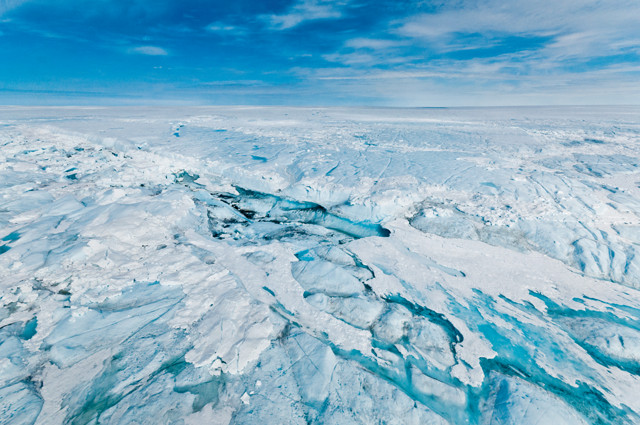
by Timothy Oleson Monday, September 21, 2015

The hydro-fracture scarp and exposed lake bed of Greenland's North Lake following a rapid drainage event in 2011 are seen here. Credit: Ian Joughin.
From Antarctica to the Arctic; from polar caps, permafrost and glaciers to ocean-rafted sea ice; and from burly bears to cold-loving microbes, fascinating science is found in every nook and crevasse of Earth’s cryosphere, and new findings are announced often. Here are a few of the latest updates.
Large meltwater lakes on the surface of Greenland’s ice sheet sometimes disappear in just a few hours, draining quickly through large but short-lived cracks in the ice beneath the lakes. What causes these cracks, or hydro-fractures, to form in the first place hasn’t been clear to scientists, but in a new study in Nature, Laura Stevens of MIT and colleagues suggest a culprit. With an array of 16 GPS stations placed around 2.5-kilometer-long North Lake, which sits atop nearly a kilometer of ice in western Greenland, Stevens’ team observed the lake drain rapidly three times between 2011 and 2013 (it refilled eventually after each event). In each case, hydro-fracture formation beneath the lake was preceded by local uplift of the ice sheet by more than 20 centimeters. The researchers hypothesized that surface-water runoff flowing down long-lasting conduits in the ice called moulins occasionally causes pressure to build up at the base of the ice sheet, which pushes up on the ice and initiates cracking from the bottom up. Once a lake is drained through the hydro-fractures, these cracks often seal up again, allowing the lake to refill.
The first direct measurement of geothermal heat flow in the ground beneath the West Antarctic Ice Sheet (WAIS) suggests that far more heat may rise into the ice sheet than was previously expected, according to a new study in Science Advances. With a temperature probe dropped 800 meters through the ice sheet and into sediment beneath Subglacial Lake Whillans, Andrew Fisher of the University of California at Santa Cruz and colleagues measured heat flow of about 285 milliwatts per square meter rising toward the ice’s underside. Previous work using indirect measurements and ice modeling had suggested the average heat flow beneath the ice sheet was closer to 100 milliwatts per square meter. It’s unclear if the higher-than-expected heat flow is localized or widespread, Fisher said in a statement, but it might help explain the abundance of subglacial lakes and ice streams in the region. However, he noted, it does not explain high rates of ice-mass loss measured recently in West Antarctica because “the ice sheet developed and evolved” with the volcanic heat source driving the heat flow already in place.
Waters off the Alaskan coast will become increasingly inhospitable to shelled marine life through the 21st century as oceans acidify, according to a new study in the journal Oceanography. Arctic waters are especially vulnerable to acidification because their cold temperatures — as well as large freshwater inputs from glaciers and rivers — allow for increased absorption of atmospheric carbon dioxide relative to warmer, saltier waters. More carbon dioxide means more acidity, and as the pH drops, the calcium carbonate mineral aragonite — which many animals, from sea snails to crabs, use to produce shells — becomes increasingly prone to dissolving rather than precipitating.
In the new study, scientists collected seawater data from the Beaufort, Bering and Chukchi seas in 2011 and 2012 while aboard the icebreaker Healy to validate an ocean-climate model, and then projected how conditions in the seas would change over the 21st century. Jeremy Mathis of NOAA’s Pacific Marine Environmental Laboratory in Seattle and colleagues reported that the annual average saturation level of aragonite “will pass below the current range of natural variability in 2025 for the Beaufort Sea and 2027 for the Chukchi Sea,” while the Bering Sea should reach this benchmark in 2044. Levels do fluctuate seasonally and with geography, the team noted, so that “some areas will not become persistently undersaturated in aragonite until 2100.” But overall, “it is probably safe to assume that [these biogeochemical changes] will have detrimental effects on ecosystems.”
© 2008-2021. All rights reserved. Any copying, redistribution or retransmission of any of the contents of this service without the expressed written permission of the American Geosciences Institute is expressly prohibited. Click here for all copyright requests.